Introduction: An Artist Between Worlds
Johannes Evert Hendrik Akkeringa stands as a significant figure in Dutch art history, a painter whose life and work bridged different worlds – geographically, from his birth in the Dutch East Indies to his career in the Netherlands, and artistically, as a notable exponent of the later Hague School and Dutch Impressionism. Born on June 17, 1861, in Blinjoe, on the island of Banka in present-day Indonesia, Akkeringa would become celebrated for his sensitive and light-filled depictions of everyday Dutch life, particularly scenes involving women and children in domestic settings, gardens, and the beloved coastal landscapes of Holland. His career spanned a period of significant artistic change, and his work reflects a deep appreciation for the quiet beauty found in simple moments, rendered with a delicate touch and a keen eye for atmosphere. He passed away in Amersfoort on April 12, 1942, leaving behind a legacy of charming and evocative paintings.
Early Life and Formative Years
Akkeringa's origins in the Dutch East Indies provided a unique starting point for a painter who would become so associated with the Dutch landscape. His family relocated to The Hague when he was young, immersing him in the cultural heart of the Netherlands. This move was pivotal, placing him in proximity to the burgeoning artistic movements that would shape his career. His formal artistic training began seriously in 1878 when he enrolled at the prestigious Koninklijke Academie van Beeldende Kunsten (Royal Academy of Fine Arts) in The Hague.
At the Academy, Akkeringa honed his technical skills in drawing and painting. This period was crucial not only for his artistic development but also for the connections he forged. He studied alongside other talented young artists who would also make their mark on Dutch art. Among his contemporaries and friends from this time were figures like Willem de Zwart and Floris Verster. The Academy provided a fertile ground for exchanging ideas and developing individual styles within the prevailing artistic currents.
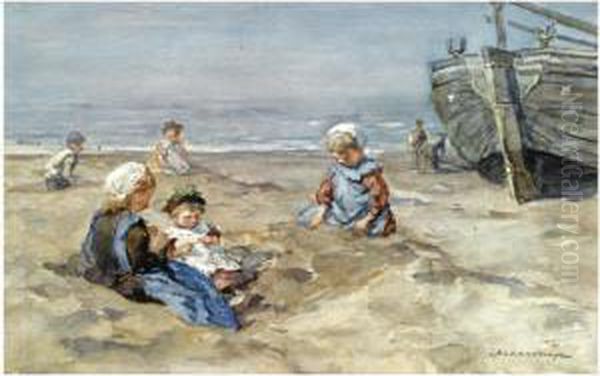
His education continued at the Rotterdam Academy before he returned to The Hague. This period of rigorous training laid the foundation for his later work, equipping him with the skills necessary to capture the nuances of light, colour, and form that characterize his paintings. The academic environment, combined with the artistic ferment in The Hague, provided the perfect crucible for his emerging talent. His mother's family background, reportedly connected to the craft of frame and mirror making, might also have subtly influenced his appreciation for presentation and composition, though his primary focus remained the painted image itself.
The Hague School Context
To understand Akkeringa's art, it is essential to place him within the context of the Hague School (Haagse School). This influential movement dominated Dutch painting in the latter half of the 19th century. Emerging around 1860, its proponents sought to break away from the idealized landscapes of Romanticism, favouring instead a more realistic and atmospheric depiction of the Dutch countryside, coastal scenes, and the lives of ordinary people, particularly fishermen and farmers.
Key figures of the first generation included Jozef Israëls, known for his poignant scenes of fishing communities; the Maris brothers – Jacob, Matthijs, and Willem – each renowned for their landscapes, cityscapes, and animal paintings; Anton Mauve, famous for his sheep flocks and rural scenes (and a cousin-in-law and early influence on Vincent van Gogh); Hendrik Willem Mesdag, celebrated for his seascapes, particularly the Panorama Mesdag; and Willem Roelofs, a pioneer of painting Dutch landscapes in a realistic, atmospheric style.
The Hague School artists were masters of capturing mood and atmosphere, often employing a tonal palette dominated by greys, browns, and muted greens – the "grey school," as it was sometimes called, reflecting the often overcast Dutch weather. They frequently worked outdoors (en plein air) to capture the fleeting effects of light and weather directly. Their focus was on the unadorned reality of Dutch life and landscape, imbued with a sense of quiet dignity and sometimes melancholy.
Akkeringa is often considered part of the second generation or a later associate of the Hague School. While his work shares the School's commitment to realism and atmospheric effects, his palette often became brighter and his touch lighter, reflecting the influence of Impressionism. He carried forward the School's interest in everyday subjects but infused them with a more intimate, often sunnier, sensibility. His connection to figures like Willem Bastiaan Tholen further places him within this evolving tradition.
Artistic Style: Light, Colour, and Atmosphere
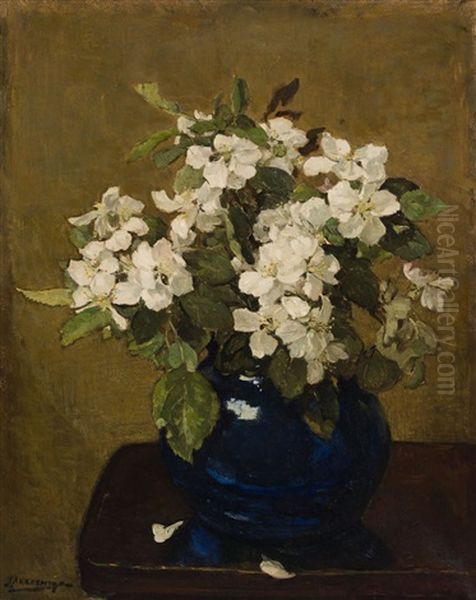
Akkeringa developed a distinctive style characterized by its sensitivity to light and atmosphere, delicate brushwork, and often harmonious colour palette. While rooted in the realism of the Hague School, his work increasingly embraced the brighter colours and looser handling associated with Impressionism, particularly in his later career. He became a master at capturing the play of sunlight, whether filtering through leaves in a garden, sparkling on the sea, or illuminating an interior.
His brushwork is often described as refined and subtle. He didn't typically employ the bold, broken brushstrokes of French Impressionism but rather used careful, often small, touches of paint to build up form and texture. This technique allowed him to render details like the petals of a flower or the fabric of clothing with great delicacy, without sacrificing the overall atmospheric unity of the scene.
Colour was central to Akkeringa's art. While capable of using the tonal palette of the Hague School, he is particularly noted for his brighter works, filled with soft blues, greens, pinks, and yellows. He excelled at depicting the specific light conditions of different times of day and seasons, creating paintings that feel fresh and immediate. His ability to convey warmth and tranquility through colour is a hallmark of his most beloved works.
A notable aspect of his technique, mentioned in some analyses, is the use of "glazing." This involves applying thin, transparent layers of paint over underlying layers, allowing light to pass through and reflect off the lower layers, creating effects of depth, luminosity, and subtle colour modulation. This technique, while traditional, was employed by Akkeringa to enhance the atmospheric richness of his paintings, adding a jewel-like quality to certain passages.
Themes: The Poetry of the Everyday
Akkeringa's choice of subjects centred on the intimate and familiar aspects of Dutch life and landscape. He found poetry in the everyday, transforming simple scenes into moments of quiet beauty and contemplation. His thematic range, while focused, allowed for considerable variation in mood and setting.
Coastal Scenes and Beach Life
The Dutch coast, particularly the beaches near The Hague such as Scheveningen, was a recurring source of inspiration for Akkeringa, as it was for many Hague School painters. However, unlike Mesdag's dramatic seascapes or Jozef Israëls' often somber depictions of fisherfolk, Akkeringa frequently focused on more cheerful and intimate scenes. His paintings of children playing on the beach are among his most charming works.
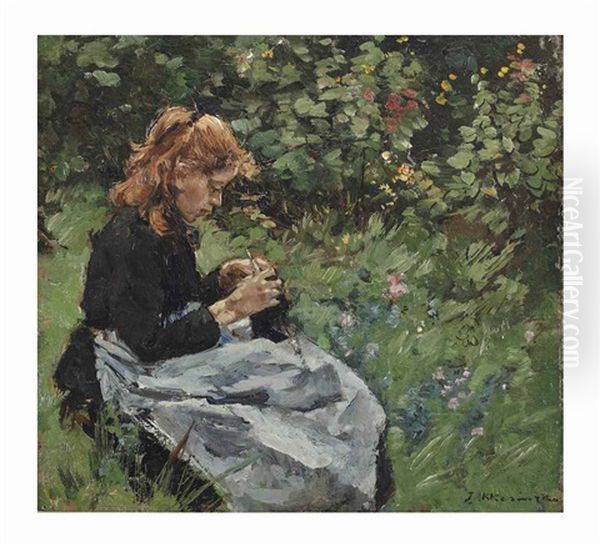
In works like Children at Play on the Beach, he captures the innocence and absorption of childhood against the backdrop of sand and sea. The figures are often rendered with sensitivity, their postures and interactions suggesting simple narratives. The light is typically bright and clear, reflecting off the wet sand and the water, conveying the freshness of the seaside air. He also depicted scenes related to the fishing industry, such as Nettenboeters in the Dunes (Net Menders in the Dunes) or Women mending fishing nets, showing local women engaged in their traditional tasks, but often with a focus on the patterns of light and the textures of the nets and surrounding dunes rather than hardship.
Gardens and Rural Idylls
Gardens were another favourite motif for Akkeringa. He painted numerous scenes set in lush, sun-dappled gardens, often featuring women or children reading, sewing, or simply enjoying the tranquility of the outdoors. These works evoke a sense of peace and domestic harmony. Afternoon in the Garden is a prime example, likely depicting a serene moment bathed in the warm light of the late day.
His interest extended to the broader rural landscape, including scenes of farm life, such as chicken farms, and the distinctive Dutch polder landscapes. He was particularly drawn to scenes featuring flowers, both in gardens and in dedicated still lifes. His depictions of blossoming trees, like the celebrated Apple Blossom, showcase his ability to capture the ephemeral beauty of nature in bloom with vibrant colour and delicate handling. Tea gardens, perhaps reflecting his Indonesian origins or simply the Dutch enjoyment of outdoor leisure, also feature in his oeuvre, often depicted on sunny days.
Still Lifes and Interiors
While best known for his landscapes and genre scenes, Akkeringa also produced exquisite still lifes, primarily focusing on flowers. These works allowed him to concentrate purely on form, colour, and texture. His floral still lifes are characterized by their delicate arrangements, subtle colour harmonies, and the same sensitivity to light found in his outdoor scenes. He often chose simple blooms, rendering them with an intimacy that makes them feel freshly picked.
Occasionally, he also painted interior scenes, often featuring women engaged in quiet domestic activities. These works share the same concern for light and atmosphere as his exterior paintings, capturing the way sunlight falls into a room or the soft glow of lamplight.
Representative Works: Moments in Time
Several paintings stand out as representative of Akkeringa's artistic achievements and recurring themes:
Children Playing on the Beach: This subject appears multiple times in his work, embodying his gentle, optimistic view of coastal life. These paintings typically feature small groups of children absorbed in their play near the water's edge, rendered in bright, clear colours and capturing the atmosphere of a day by the sea.
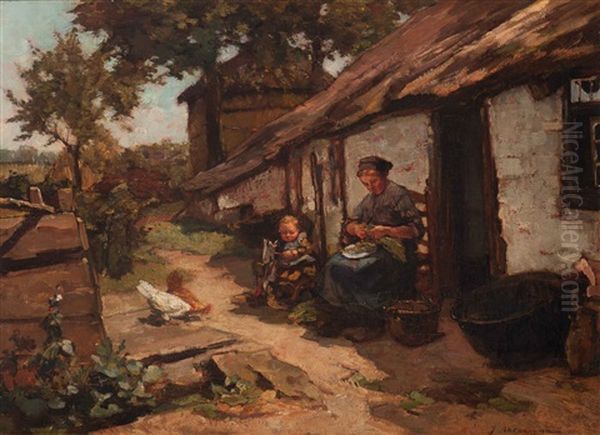
Nettenboeters in the Dunes (Net Menders in the Dunes): Depicting women mending fishing nets, often seated amidst the undulating sand dunes, this theme connects Akkeringa to the Hague School's interest in local labour. His versions often emphasize the picturesque quality of the scene, the textures of the nets, and the play of light on the sand and figures. A specific painting titled Women mending fishing nets (1932) is noted for its composition and execution on canvas.
Apple Blossom (c. 1900): Considered a masterpiece of Dutch Impressionism, this work captures the vibrant beauty of an apple tree in full bloom. Akkeringa uses lively brushwork and a bright palette of pinks, whites, greens, and blues to convey the freshness and vitality of spring. The painting demonstrates his skill in rendering natural textures and the effects of sunlight filtering through blossoms and leaves. It was well-received upon its exhibition.
Afternoon in the Garden: Representative of his many garden scenes, this title suggests a tranquil moment captured in the warm, slanting light of the afternoon. Such works typically feature figures relaxing or engaged in quiet activities amidst flowers and foliage, emphasizing harmony between humanity and nature.
Behind the House: Noted as an important earlier work, this painting likely depicts a figure in a garden setting, showcasing Akkeringa's developing ability to handle light, shadow, and atmosphere, possibly using the glazing technique to achieve depth and luminosity.
These works, along with his depictions of tea gardens, flower still lifes, and harbour views, collectively illustrate Akkeringa's focus on capturing the beauty and tranquility of everyday moments through a refined Impressionistic lens.
Contemporaries, Connections, and Influence
Akkeringa's artistic journey was interwoven with those of his contemporaries. His friendships formed at the Academy with Willem de Zwart and Isaac Israëls were significant. De Zwart, known for his robust brushwork and diverse subjects ranging from cityscapes to stables, shared Akkeringa's interest in capturing everyday life, though often with a more vigorous technique. Isaac Israëls, son of the Hague School leader Jozef Israëls, became a leading figure of Amsterdam Impressionism, famous for his dynamic depictions of urban life, fashion, and leisure. Their youthful association likely involved mutual influence and shared exploration of modern painting techniques.
His connection with Floris Verster, another fellow student, also points to his integration within the Dutch art scene. Verster became known for his highly detailed and intensely coloured still lifes and figure paintings, developing a unique style that diverged from mainstream Impressionism. Akkeringa's association with these varied talents highlights the rich artistic environment in which he worked.
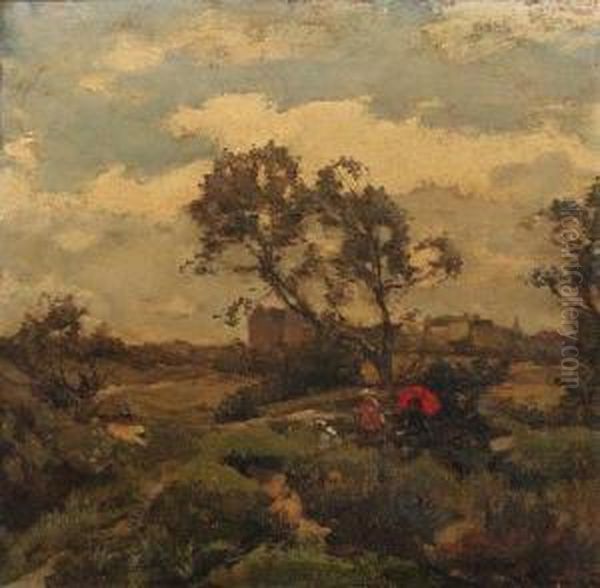
Beyond his immediate circle, Akkeringa's work resonates with other artists associated with the later Hague School and Dutch Impressionism. Willem Bastiaan Tholen, for instance, shared Akkeringa's interest in intimate landscapes, garden views, and scenes featuring boats and water, often rendered with a similar sensitivity to light. While perhaps less radical than Amsterdam Impressionists like George Hendrik Breitner, known for his gritty urban scenes and powerful brushwork, Akkeringa contributed significantly to the strand of Dutch painting that focused on capturing light, atmosphere, and the charm of rural and domestic life.
His influence can be seen in the continuation of these themes by later Dutch painters. His ability to find beauty in the commonplace and render it with technical finesse and atmospheric sensitivity provided a model for artists seeking to portray the national landscape and lifestyle in an intimate, accessible manner. His work maintained a connection to the observational traditions of the Hague School while embracing the brighter palette of Impressionism, offering a bridge between these movements.
A Lesser-Known Facet: Engineering Innovation
Interestingly, Akkeringa's talents were not confined solely to the canvas. The historical record, as noted in the provided information, mentions a surprising detour into engineering. In the late 19th century, likely drawing on knowledge related to his birthplace's prominence in tin mining (Banka Island was a major tin producer), Johannes Evert Hendrik Akkeringa is credited with designing a novel drilling system specifically for tin exploration.
This system was reportedly implemented and tested successfully on Banka Island itself. While details of the mechanism or its long-term impact are scarce in art historical accounts, this anecdote reveals a practical, inventive side to the artist. It stands as a curious footnote to a life primarily dedicated to the pursuit of visual beauty, suggesting a mind capable of both aesthetic sensitivity and technical problem-solving. This aspect, however, remains distinct from his established identity and legacy as a painter.
Legacy and Recognition
Johannes Evert Akkeringa achieved considerable recognition during his lifetime and remains a respected figure in Dutch art history. His paintings were regularly exhibited in the Netherlands, including at prestigious venues in The Hague and Amsterdam, where they were often praised for their charm and technical skill. Works like Apple Blossom received positive critical attention when first shown.
His paintings found their way into important public and private collections. Today, his works are held by major Dutch museums, including the Rijksmuseum in Amsterdam and the Mauritshuis in The Hague, as well as numerous regional museums and private collections internationally. The presence of his work in these institutions confirms his enduring status.
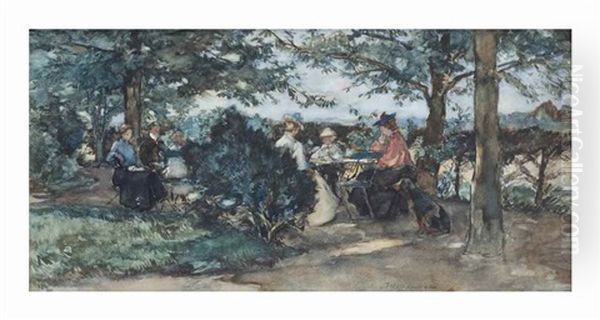
Akkeringa's paintings continue to be sought after on the art market, appearing regularly at auctions specializing in 19th and early 20th-century European art. The enduring appeal of his subjects – sunny beaches, peaceful gardens, delicate flowers – combined with his skillful execution, ensures continued interest from collectors.
His primary legacy lies in his contribution to Dutch Impressionism and the later phase of the Hague School. He successfully translated the core tenets of these movements – realism, attention to atmosphere, capturing fleeting moments – into a personal style characterized by intimacy, light, and often a gentle optimism. He excelled at portraying the simple pleasures and quiet beauty of Dutch life, creating a body of work that continues to resonate with viewers for its warmth and sincerity. He remains an important painter for understanding the evolution of Dutch art around the turn of the 20th century.
Conclusion: An Enduring Vision of Tranquility
Johannes Evert Hendrik Akkeringa carved a distinct niche for himself within the rich tapestry of Dutch art. Born far from the Netherlands but becoming one of its sensitive chroniclers, he absorbed the lessons of the Hague School and infused them with the lighter palette and atmospheric concerns of Impressionism. His paintings, whether depicting children absorbed in play on a sunlit beach, the quietude of a blooming garden, or the delicate beauty of flowers, consistently speak of a search for harmony and tranquility.
He was not a painter of grand historical events or dramatic social commentary, but rather an artist who found profound meaning in the everyday. Through his delicate brushwork, his masterful handling of light, and his harmonious use of colour, Akkeringa invites viewers into intimate moments of peace and simple beauty. His friendships with key figures like Willem de Zwart and Isaac Israëls place him firmly within the artistic dialogues of his time, while his unique background and perhaps even his brief foray into engineering hint at a multifaceted personality. Ultimately, Johannes Evert Akkeringa's enduring legacy rests on his ability to capture the gentle light and quiet poetry of Dutch life, leaving behind a body of work that continues to offer solace and delight.